Forget Asia-Pacific its the Indo-Pacific we live in now Where is that exactly
Mermaids and monsters ply the seas in a colourful map belonging to former diplomat Rory Medcalf. The map was created by Flemish cartographer Abraham Ortelius in 1571, just decades after the globe had been first circumnavigated, and yet it is strikingly modern, says Medcalf, “monsters and mermaids asideâ€.
The map frames a section of the world: the Persian Gulf is at left, a sprawling India and China are in the centre and North America is at top right. Australia is a little mauve island at the bottom, labelled “Beachâ€.
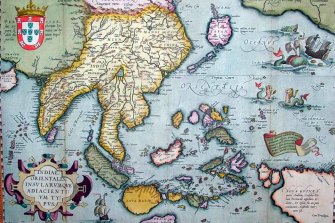
A map of the Indo-Pacific in 1570 by Ortelius of Antwerp, combining Asia, North America and the edge of Australia (marked ‘Beach’) as one region.
Quaint it may seem but, in some respects at least, the map shows what we know today as the Indo-Pacific.
Indo-Pacific, a term once used mostly by marine biologists and bio-geographers, has become common parlance among diplomats, bureaucrats and politicians, finding particularly free and full expression at events such as G7 meetings. In Cornwall in June, talk of the Indo-Pacific was there at every turn. “A free and open Indo-Pacific is essential to each of our futures,†said US President Joe Biden. “The Indo-Pacific is the epicentre of strategic competition,†said Australian Prime Minister Scott Morrison. “Nowhere,†said Australian Foreign Minister Marise Payne, “is change happening more rapidly than in our region, in the Indo-Pacific.â€
In August, as Biden defended the US exit from Afghanistan, Vice President Kamala Harris was in south-east Asia affirming her nation’s “proud part†in the Indo-Pacific â€" “some of our closest allies and strongest partners are hereâ€. When the Australia, New Zealand, United States Security Treaty recently marked its 70th anniversary, Morrison told Parliament, “ANZUS is the foundation stone of Australia’s national security and a key pillar for peace and stability in our Indo-Pacific region.â€
And a new “Indo-Pacific†security pact called AUKUS (pronounced AWK-us) was unveiled in September, with Biden noting “we all recognise the imperative of ensuring peace and stability in the Indo-Pacific over the long termâ€. The US will help Australia develop a nuclear-powered submarine fleet; and Australia, the UK and the US will share information in areas such as long-range strike capabilities, artificial intelligence, cyber and quantum technology.
So, what does Indo-Pacific mean? Where does it begin and end? And who are Australia’s friends in this region today?
Why do we need a new term to talk about where we live?There was a time, not so long ago, when we said Australia was part of the “Asia-Pacificâ€. While there were never any hard and fast borders attached to the term, it implied a focus on nations in and around the Western Pacific Ocean: the Pacific islands, south-east Asia and up into Japan and China. In a bid to evolve Australia from its Anglo-American and European-facing world view, prime minister Paul Keating contended in 1993 that Australia needed to “look to the Asia-Pacific because that is where our great opportunity is. It is where our future liesâ€.
At that time, our most powerful ally was the United States, and its supremacy was unchallenged in the region. But for about a decade, this has been changing.
China, under President Xi Jinping, has become more assertive. There has been controversy over islands and reefs in the South China Sea being turned into military bases and airstrips. Beijing has moved to reassert control over Hong Kong decades ahead of an undertaking that the “administrative region†would remain under one-country, two-systems until 2049. And Xi has publicly said that it is time for Taiwan to also come back to the fold.
And other concerns are now part of the picture too, not least the ongoing threat of Islamic terrorism, the rising challenge of far-right extremism, and challenges posed by authoritarian countries such as Russia and North Korea. There is more talk of “grey zone†warfare, those aggressions such as cyber attacks and disinformation campaigns that fall between what we traditionally view as war â€" with its open, kinetic aggression â€" and peace.
The Prime Minister has declared that Australia is facing the most challenging security environment since the end of World War II.
Amid all of this, the United States is declining relative to China, across several measures of economic and military power â€" enough to shake decades-old assumptions about its domination in this region.
The world’s second-most populous nation after China, India, has transformed from a South Asian power with a non-aligned foreign policy into a nation increasingly capable of influencing and shaping outcomes in the wider region. This is even while domestic issues, including widespread poverty, hold it back from being a peer competitor with China, which has become the world’s second-largest economy after the US, claiming to have eliminated absolute poverty in 2021, the 100th anniversary of the Communist Party.
Seas around the world are becoming sites of geopolitical jockeying and the Indian Ocean is no exception. Off the west coast of Australia, significant changes are afoot. The ocean is home to major commercial shipping routes that connect the Middle East and East Asia via the Malacca Straits. Beijing’s navy has been growing its presence in this ocean, linked to factors such as its growing reliance on Middle East oil shipments and its objective to spread its influence to the east. It has launched infrastructure blitzes in Sri Lanka and throughout east Africa as part of Xi’s signature foreign policy Belt and Road Initiative, the “Road†referring to the Maritime Silk Road used to transport goods from Africa across the Indian Ocean and up into China via south-east Asia.
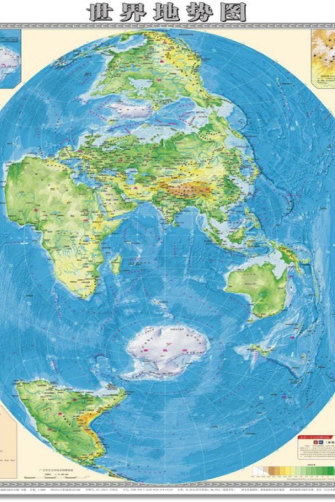
In 2013, the Chinese Academy of Sciences announced that geophysicist Hao Xiaoguang had drawn a new map of the world.
Enter the Indo-Pacific.
Former US secretary of state Hillary Clinton used the term in 2010, but Australia was the first country to refer to it in official documents â€" the 2013 Defence White Paper makes 58 mentions while the 2017 Foreign Policy White Paper defines it. By Australia’s reckoning, the Indo-Pacific ranges from the eastern Indian Ocean to the Pacific, connected by south-east Asia, home to nine of Australia’s top 10 trading partners. But the boundaries are not fixed.
Countries such as the US and India define the Indo-Pacific as the entire Indian Ocean region, extending to Africa’s east coast. The European Union’s ambassador to Australia, Michael Pulch, says European nations define the region “a bit largerâ€. “We define it from starting at the west coast of Africa, and ending in the South Pacific,†he says. Despite, or perhaps because of its fluidity, the term has been adopted by India, Indonesia, Japan and the 10 countries that make up the Association of Southeast Asian Nations (ASEAN).
Medcalf, a national security analyst who wrote the book Contest for the Indo-Pacific: Why China Won’t Map the Future (2020), says the Indo-Pacific does have “a recognisable core in maritime south-east Asia â€" the sea lanes, the archipelago of Indonesia, the South China Seaâ€.
“The margins will shift according to the issue at hand … If we’re talking about China building military bases on the east coast of Africa, that’s an Indo-Pacific issue. If we’re talking about the day-to-day diplomacy and politics of east African countries with one another, that’s their issue,†says Medcalf, now the head of the National Security College at the Australian National University.
Only Russia and China consistently reject the term, says Medcalf, with the two countries seeing the enlarged definition of the region as an attempt to bring in more countries to contain them.
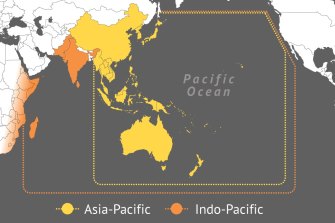
The Indo-Pacific covers a broader area than the Asia-Pacific, including India. Credit:
Isn’t this all just semantics?If this all sounds a bit rhetorical, Medcalf points out that the Indo-Pacific is no less “invented†than the Asia-Pacific â€" but the Asia-Pacific “marginalised or excluded†India and the Indian Ocean. It is “a place, an idea and a wave sweeping global diplomacy,†he says of the Indo-Pacific. “It reframes an Asia-centric region to reflect growing connectivity and contest across two oceans.†Rather than one superpower being in charge, or two butting heads, it involves “an expansive array of new partnershipsâ€.
“We thus have a metaphor for collective action, code for a globally vital region where China can be prominent but not dominant.â€
It also cuts through questions about Australia’s place in Asia. “Here, at last, is a definition of our region in which Australia unequivocally belongs, transcending the old debate about whether or not Australia is an Asian country.â€
India, meanwhile, has its own reasons for wanting to be on the Indo-Pacific map. An ancient civilisation, as is China, it lives in an uneasy symbiosis with its northern neighbour, dependent on China for goods such as machinery, semiconductors and pharmaceuticals. The nations share a border that runs through the Himalayas, the exact boundaries of which are so contested that fatal hand-to-hand fighting has broken out between Indian and Chinese troops there recently.
“Concern in India about China’s regional ambitions have grown sharply in recent years and are now amplified again by the brutal border clashes of past months,†says Medcalf. “India sees itself as a civilisational peer of China, even if its economy is much smaller.â€
As for Australia’s relationship with India, the two nations signed a strategic partnership in 2009, which led to them sharing in joint military exercises and more regular dialogue between its political leaders. The relationship is still hampered by the lack of a free trade agreement, though, with India’s protectionist instinct making it difficult to contemplate a deal.
Still, Richard Maude, a former Office of National Assessments boss who wrote the 2017 White Paper defining our version of the Indo-Pacific, says the importance of India to Australia is clear “as an increasingly substantial bilateral relationship in its own right and as a partner in shared efforts to build a multi-polar region rather than one dominated solely by Chinaâ€.
India will engage with the region “on its own termsâ€, he says. “[India] doesn’t do alliances and values strategic autonomy. But competition with China is nonetheless driving stronger convergences between India and its fellow Quad members.â€
What’s the Quad and where does it fit in?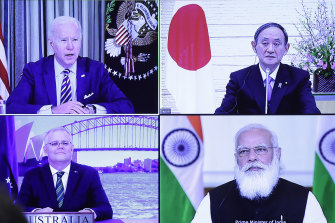
US leader Joe Biden, Japan’s Yoshihide Suga, Australia’s Scott Morrison and India’s Narendra Modi during a virtual Quad meeting hosted by Japan in March.Credit:Bloomberg
Made up of Australia in the south, Japan in the north, India in the west and the US in the east, the Quad, or Quadrilateral Security Dialogue, encapsulates the Indo-Pacific world order. The Quad was conceived in the wake of the Boxing Day tsunami in 2004 when the four nations co-ordinated relief. Its members didn’t meet until 2007, when they also conducted a large naval exercise with Singapore. An unimpressed Beijing saw the grouping as an “Asian NATO†designed to contain China. In any case, the Quad did not gain traction and the Rudd government announced its demise in 2008.
But the years that followed were dominated by China’s shows of strength in the region such that officials from the four countries met five times between 2017 and 2020, with each nation’s leaders finally meeting in 2021, a get-together Maude describes as a “dramatic leap forward for the Quad†and “one of the most significant developments in Indo-Pacific security architecture in recent yearsâ€. The 2021 meeting did not mention China by name; rather, members committed to deliver equitable COVID-19 vaccines to the region and collaborate on tackling climate change and driving technological innovation.
All the same, “the Quad has a signalling functionâ€, says Maude. “It demonstrates to China that its aggression and zero-sum diplomacy in the region are creating a balancing coalition against China: the very thing that China fears. It similarly demonstrates resolve to other countries in the region feeling the press of China’s power, notably south-east Asia.†Japan, the US and India invited Australia to join their Malabar naval exercises in 2020, bringing a military dimension to the group, even though the exercises are not done under the Quad banner.
While the Quad’s rebirth occurred under former US president Donald Trump, Maude says the Biden administration’s early and obvious commitment to the forum has given it new energy and a practical agenda. “It is helping move the Quad from something that simply signals to a group that can act,†he says. “Importantly, the key initiatives coming out of the recent summit were about supporting the region at a time of need, not overtly about pushing back against China.â€
Medcalf says responding to the COVID-19 outbreak in India was an important test for the Quad. The US had been criticised for not releasing surplus COVID-19 vaccines to India. “After some initial hesitation, they are all in,†Medcalf says. “I think the record will show that Australia played an important role in encouraging the US to assist its fellow Quad member in distress.â€
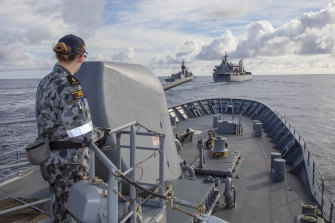
The Australian Navy accepted India’s invitation to participate in the Malabar 2020 naval exercise in the South China Sea. Credit:Royal Australian Navy
Asked whether the Quad will form into a hard-headed security alliance like NATO or a soft multilateral grouping like ASEAN (see below), Medcalf says for now it is “something in between†and its future depends on China’s actions. “The more China seeks to coerce individual countries in the region … the stronger the Quad is likely to get and the more that the countries of the Quad will be willing to take the steps of strengthening ties.â€
Of course, some of the Quad members already have longstanding ties. The US and Japan have had a security treaty since 1951. The 70th anniversary of the ANZUS treaty was celebrated on September 1. While the US, Australia and New Zealand have participated in wars in Korea, Vietnam and Iraq, the ANZUS alliance has been invoked once, when the Howard government used it as the basis for its participation in the invasion of Afghanistan after the September 11 terror attacks.
“The alliance with the US remains fundamental,†says Medcalf, “because of not only the relative convergence of values, especially in a post-Trump America, but because of the exceptional strategic power and weight the US brings to helping Australia protect itself. The simple fact is that Australia could contribute to its defence but does not have the capacity to defend itself in a major conflict, he says.
Medcalf says there is no expectation among Quad members that they would go to war together in the case that, for example, hostilities escalated over a crisis in Taiwan. He says it would be more likely Australia, Japan and the US would work together in a military confrontation and India would be an “optional in or outâ€. “If [India’s] relations of mistrust with China continue to worsen, we shouldn’t be saying there is a strict limit to what the Quad can do together,†he says.
He points to the potential for a “Quad-plus†arrangement to deal with specific situations as they arise. Countries including New Zealand and Vietnam were added to phone hook-ups among Quad countries in March 2020, but the idea of a Quad-plus is still in its early days.
What does ASEAN do?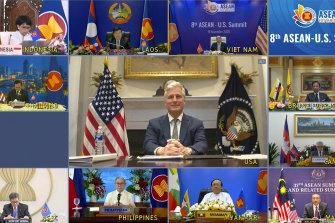
US national security adviser Robert O’Brien addresses a virtual ASEAN summit in 2020.Credit:AP
The 10 nations of south-east Asia have their own forum that works with other powers. ASEAN, the Association of Southeast Asian Nations, is an economic union made up of Brunei, Cambodia, Indonesia, Laos, Malaysia, Myanmar, the Philippines, Singapore, Thailand, and Vietnam that is also a key regional forum for dealing with geopolitical issues. Australia became the first of ASEAN’s 10 dialogue partners in 1974 and participates in most of its forums.
ASEAN is regularly criticised for its lack of effective action in dealing with challenges in the region, most notably in its response to the recent military coup in Myanmar. ASEAN has released statements urging an immediate halt to the violence in Myanmar but has not moved to put direct pressure on the country’s military government through sanctions. Medcalf says ASEAN is significant mainly because of what it symbolises; “a commitment among the 10 countries at the geographic core of the Indo-Pacific to preserve stability and coexistence among themselves and to act as a diplomatic convenor for the wider region to discourage major power rivalryâ€.
But while it has the respect of other countries as a relatively neutral ground for diplomacy, it has its weaknesses, he says, providing restraints on China’s power “but not enough by itselfâ€. Medcalf says the limits of ASEAN is one of the reasons why “minilateral forums†such as the Quad are forming. “Those minilateral forums are more effective at rapidly co-ordinating and you don’t have to abide by the consensus rule of ASEAN.†Medcalf warns ASEAN’s members could look elsewhere to get things done.
The East Asia Summit consists of the ASEAN countries as well Australia, New Zealand, India, the US and Russia. When the EAS was established in 2005, China tried to block Australia and New Zealand from joining but the two countries got on board with support from Japan, Singapore, Indonesia and other south-east Asian countries. When the US joined in 2010, and Russia joined with the encouragement of China, the EAS encompassed all points of the Indo-Pacific.
Does the Commonwealth still matter?The Commonwealth â€" the 54 nations that once made up the British Empire â€" is not entirely obsolete but it has been fading in significance over the past few decades. Back in the days of apartheid, the Commonwealth played a key role in imposing economic sanctions against South Africa, with its then-secretary general Sonny Ramphal an important voice in campaigning against racism and the denial of human rights in the country.
It is difficult to see the institution being used today as the key vehicle to drive change on the international stage. Still, Medcalf says it is not worth jettisoning the Commonwealth as an institution because it has some “latent value†in standing up for democratic principles and the protection of democratic institutions. “That is certainly part of the glue and heritage of most Commonwealth countries,†he says. “And many important Commonwealth countries are in the Indo-Pacific.â€
Where does Europe factor in all this?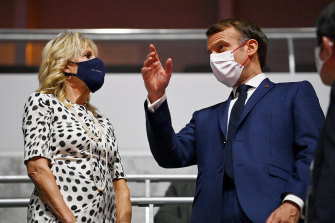
US First Lady Jill Biden and French President Emmanuel Macron at the Olympics Opening Ceremony in Tokyo.Credit:Getty Images
The heightened attention on the Indo-Pacific does not mean other allies in Europe are no longer important. Britain’s exit from the European Union means it is looking to forge closer economic relations with countries further afield, including Australia â€" Canberra has secured a free trade agreement with Britain and negotiating one with the European Union.
The EU is also developing its own Indo-Pacific strategy. Pulch, its top diplomat in Canberra, says “we don’t see ourselves as coming back†to the region because in many ways it never left.
“Many European countries have longstanding relationships with the region, and that includes also partly as colonial powers in the past but also as traders, as countries that have cultural links and so forth,†he says. “But the focus is sharper these days because we all recognise the importance of this region for the stability and prosperity of the entire world … two-thirds of the global growth will come from the Indo-Pacific.
“So we think that we can bring a lot to the table here, for countries in the region in forms of investment, in forms of trade, development, aid but also as a provider of security and support of the multilateral-rules-based system, which was under strain, as we know.â€
Medcalf says Europe has become increasingly relevant in the Indo-Pacific with Brussels now seeing China as a systemic rival, particularly in the battle for cutting-edge technologies such as 5G. “There is the beginning of a global consciousness that’s bringing European powers back to the Indo-Pacific, he says. “Now, that doesn’t mean their navies are going to come back in force, but it all makes a difference in standing up for the rules-based order in the region because most of the clashes and conflicts here are going to be grey-zone â€" coercion short of war, rather than all-out war.
“The very fact that European technologies at the moment is the main alternative to 5G is one way that Europe can make a strategic difference in the region. Europe also retains high levels of trust in south-east Asia and can provide options other than Chinese investment and development assistance.â€
Closer to home, Medcalf says Australia needs to invest in institutions such as the Pacific Islands Forum and the Indian Ocean Rim Association. “One strong argument is that Australia should consolidate and strengthen its position as the convenor of choice among many of these organisations because we’re in just about all of them and we still have capacity and credibility in most of them as well.â€
Whether they’re in the region or not, everyone is now looking to the Indo-Pacific. It is more than a colourful map.
Strategic friends: a quick guide to other alliances
0 Response to "Forget Asia-Pacific its the Indo-Pacific we live in now Where is that exactly"
Post a Comment